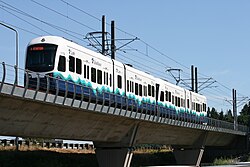Central Link
| Central Link | |
|---|---|

2-car train on an elevated guideway in Tukwila
|
|
| Overview | |
| Type | Light rail |
| System | Link light rail |
| Termini |
University of Washington Angle Lake |
| Stations | 16 |
| Daily ridership | 69,125 (August 2016, weekdays) |
| Website | Sound Transit |
| Operation | |
| Opened | July 18, 2009 |
| Owner | Sound Transit |
| Operator(s) | King County Metro |
| Character | Underground, at grade, elevated |
| Technical | |
| Line length | 20.35 mi (32.8 km) |
| Number of tracks | 2 |
| Track gauge | 4 ft 8 1⁄2 in (1,435 mm) |
| Electrification | 1,500 Volts DC, overhead catenary |
Central Link is a light rail line running between the cities of Seattle and SeaTac. It is one of the lines in Sound Transit's Link Light Rail system. Service operates seven days a week, from 5 am to 1 am Monday through Saturday and from 6 am to midnight on Sundays. Trains are composed of two or more cars, each with a capacity of 200 passengers—74 seated and 126 standing. Opened on July 18, 2009, Central Link initially operated between downtown Seattle and Tukwila, on a 13.9-mile (22.4 km) route. Service was extended by 1.7 miles (2.7 km) from Tukwila to SeaTac/Airport on December 19, 2009, by 3.15 miles (5.07 km) from Westlake to the University of Washington on March 19, 2016, and by 1.6 miles (2.6 km) from SeaTac/Airport to Angle Lake on September 24, 2016 for a system total of 20.35 miles (32.75 km).
The northern terminus is at the University of Washington, next to Husky Stadium, where construction on a northern extension is in progress. From there, it travels through a tunnel to Capitol Hill Station on Broadway. The tunnel then transitions into the Downtown Seattle Transit Tunnel at Westlake Station.
Westlake Station is near the intersection of Pine Street and 4th Avenue. Central Link trains operate inside the Downtown Seattle Transit Tunnel, sharing the right-of-way with diesel-electric hybrid buses. The route serves four of the tunnel's five stations (Convention Place Station being the exception). After exiting the southern end of the tunnel at International District/Chinatown Station, the route joins the SoDo Busway (formerly 5th Avenue S.) as a traffic-separated surface route, where it has priority for all intersections. The route serves two stations on the busway and then rises to an elevated section through the SoDo neighborhood.
...
Wikipedia
